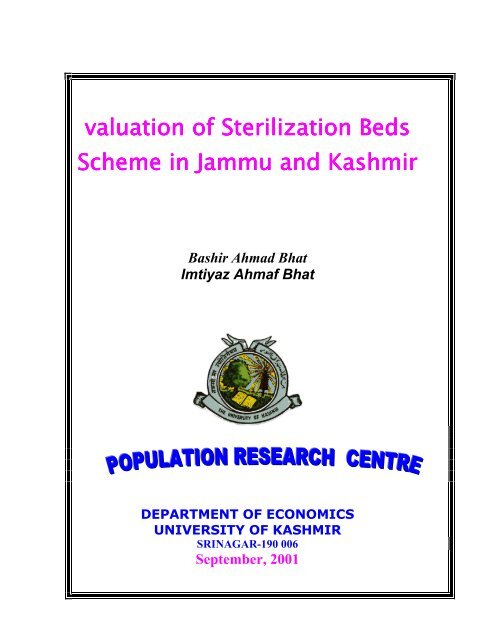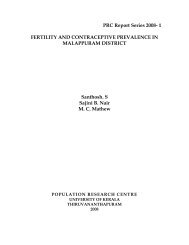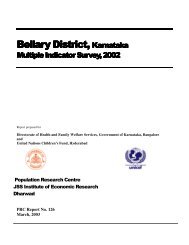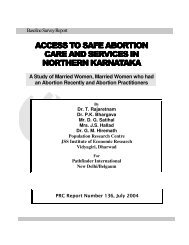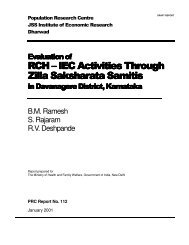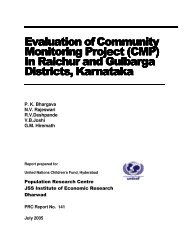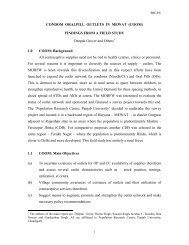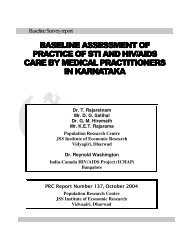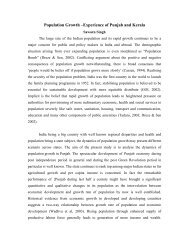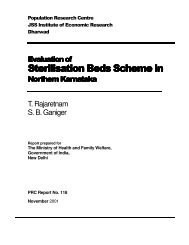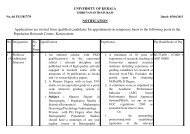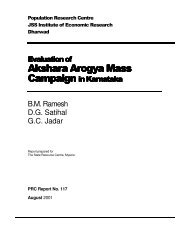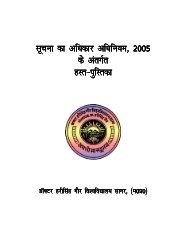PrimoPDF, Job 2 - PRC
PrimoPDF, Job 2 - PRC
PrimoPDF, Job 2 - PRC
Create successful ePaper yourself
Turn your PDF publications into a flip-book with our unique Google optimized e-Paper software.
valuation of Sterilization BedsScheme in Jammu and KashmirBashir Ahmad BhatImtiyaz Ahmaf BhatDEPARTMENT OF ECONOMICSUNIVERSITY OF KASHMIRSRINAGAR-190 006September, 2001
21. INTRODUCTIONIn 1951, India became the first country in the developing world to initiate a statesponsoredfamily planning programme as an integral part of its socio-economicdevelopment plan. Since then the family planning programme has grown steadily incoverage and today it is the largest voluntary programme administered by anygovernment. Initially a clinical based approach was adopted which was soon replaced byan extension cafeteria based approach. Under the cafeteria approach all available methodsof family planning are offered to the people with the choice left to them. But in actualpractice, it is found that sterilization has received heavy emphasis from the verybeginning of the programme. Thus sterilizations have become more popular among thecouples than the spacing methods. The popularity of the sterilization is borne by the factthat sterilization acceptors account for about three-fourth of the contraception users in thecountry.Various schemes and approaches have been used to popularize the sterilizationprogramme in the country. For example, intensive efforts were launched to promotefamily planning through provision of sterilizations at district, tehsil and block level.Similarly mass vasectomy camps were organized to give further boost to the sterilizationprogramme. The government also offered incentives to the acceptors of sterilization andto health workers for motivating and performing sterilizations. Further, cooperation wassought from private sector, local bodies and Non Governmental Organizations (NGOs) tocompliment the efforts of the government in providing sterilization services to couples.Though a number of private sector institutions and NGOs are participating in theprogramme, but the health institutions managed by the NGOs and Local Bodies arelacking basic infrastructure for performing sterilizations. Keeping in view this limitationof private institutions and institutions run by NGOs, government decided to provide somefinancial assistance under Sterilization Beds Scheme to these institutions offeringsterilization services.In this connection a scheme for reservation of sterilization beds in Hospitals runby Government, Local Bodies and Voluntary Organizations was introduced in the year1964 in order to provide immediate facilities for tubectomy operations in hospitals where
3such cases could not be admitted due to lack of beds etc. But later with the introductionof Post Partum Programme some of the beds were transferred to Post Partum Programmeand thereafter the beds were only sanctioned to hospitals run by Local Bodies andVoluntary Organizations.The grant for maintenance of the sterilization beds has been raised from Rs. 3000to Rs. 4500 per bed per annum with effect from 1.4.1995 for the institutions/localbodies/voluntary organizations participating under the scheme subject to the conditionthat a minimum of 60 tubectomies per bed per annum are achieved. If the localbody/voluntary organization fails to achieve this target but achieves a level of 45tubectomies per bed per annum, the maintenance grant @ Rs. 3000 per bed per annum isadmissible. If the performance of an institution is below the target level of 45tubectomies per bed per annum, proportionate grant at the norm of 45 tubectomies perbed per annum or at the of Rs. 3000 per bed per annum is admissible.Since the Sterilization Beds Scheme (SBC) is in operation for a long time and it isdesirable to examine the performance of this scheme. The Ministry of Health and FamilyWelfare (Government of India) decided to carry out a evaluation of the performance ofthe scheme by the Population Research Centres (<strong>PRC</strong>s). Accordingly, all the <strong>PRC</strong>s in thecountry were requested to evaluate the Sterilization Beds Scheme based on field data inthe states in which they are located. <strong>PRC</strong>, Srinagar was entrusted with the job ofundertaking this evaluation exercise in Jammu and Kashmir and the present report is theoutcome of such an evaluation.2. ObjectiveThe objectives of the study are:(1) To know whether the sterilization beds sanctioned to the organizationsunder the sterilization beds scheme are physically present.(2) To know the present status of availability of medical personal,equipments and facilities with the institution required for performingsterilization.
4(3) To know the quarterly distribution of sterilization performed by theinstitute during the year 1999-2000 and 2000-2001.(4) To know the demographic characteristics of the acceptors and theireligibility status.(5) To verify the authenticity of the sterilizations performed.(6) To know the ratio of beds reserved under the scheme to total bedsavailable(7) To know the bottlenecks of the scheme and(8) To make suggestions for the greater acceptance and improvements inthe functioning of the scheme.3. MethodologyAs per the information provided by the Ministry of Health and Family Welfare,Government of India, there are only two institutions in Jammu and Kashmir, which offerfamily welfare services under the Sterilization Bed Scheme. These are (1) Khanam’sHospital and Nursing Home, Srinagar and (2) John Bishop Memorial (JBM) HospitalAnantnag. Khanam’s Hospital and Nursing Home, Srinagar has 2 beds and John BishopMemorial Hospital has 12 beds sanctioned under the Sterilization Bed Scheme. Boththese institutions were taken up for evaluation. It was decided to verify the authenticity ofthe sterilizations performed by the institutions for ten percent of the acceptors of 1999-2000 and 2000-2001.The survey team first visited the two hospitals to ascertain whether theSterilization Bed Scheme is in operation in these hospitals or not. It was reported by theMedical Superintendent of the Khanam’s Hospital and Nursing Home, Srinagar that theirhospital is not registered under the Sterilization Bed Scheme with the State governmentand they have not received any financial assistance either from the Central Governmentor from the State Government for the implementation of the scheme. The hospitaltherefore, is not providing any services under the Sterilization Bed Scheme. Therefore,this institute was not considered for further analysis. However, some basic informationabout the institute and reasons for the inclusion of the name of the hospital in the list of
5the institutes under Sterilization Bed Scheme were collected for this hospital. So far asthe JBM Hospital Anantnag is concerned, it was found that the hospital is registered withthe State Government for offering family planning services under the Sterilization BedScheme. Detailed information was collected from this hospital as per the institutionalquestionnaire. The institute had performed 760 sterilizations during the reference period(1999-2001). Of these 389 were performed during 1999-2000 and 371 were performedduring 2000-2001. It was envisaged to verify 10 percent of the total acceptors of 1999-2000 and 2000-2001. Thus a total of 76 acceptors were selected for interview.Table 1Performance of sterilizations for the year 1999-2001 and visited for interviews (JBMH)Year Number of Sterilizations. Selected % Selected1999-2000 389 51 13.12000-2001 371 25 06.7Total: 760 76 10.0All the acceptors who had accepted the sterilization from JBM Hospital Anantnagduring 1999-2001 were tabulated by actual place of residence mentioned in the casecards/registers. During this exercise, it was noted that some women belonging to otherdistricts of Kashmir Valley had also availed the sterilization services from this institute.All the villages and urban areas were arranged in descending order based on the numberof acceptors of sterilization. The first few villages/urban blocks, which provided therequired number of acceptors (76) were selected for verification. In this way a total of 4villages (Mutton, Seer, Gopalpora and Yaripora) and the urban block of Sarnal inAnantnag town was selected for data collection. The villages/urban areas and the numberof acceptors of sterilization selected and interviewed are presented in Table 2.
6Table No: 2Village wise distribution of women selected and interviewed_________________________________________________________________________S.No. Village No. of sterilizations Contacted % contacted_________________________________________________________________________01 Mattan 18 12 66.602 Seer 20 13 65.003 Gopalpur 13 09 69.004 Sernal 16 12 75.005 Yaripora 09 05 55.6Total: 76 51 67.13.1 QuestionnaireMinistry had devised two sets of questionnaires for this evaluation exercise. Thefirst set of questionnaire was for the institutions and the second was for the acceptors.The institutional schedule listed the information regarding the areas of operation,population covered, availability of beds, infrastructure, manpower and clinical facilities,workload of the institution and participation of the institute in other scheme of health andfamily welfare. The institutional schedule also collected information regarding theperformance of the scheme and various socio-economic and demographic characteristicsof the acceptors of sterilization in detail. The acceptors schedule verified the authenticityof the acceptors and also collected some information regarding various characteristics ofthe acceptors, follow-up services and satisfaction with the services provided by theinstitution. The questionnaires provided by the Ministry were modified to incorporate thelocal state specific needs of the scheme.3.2 Field work and Data ProcessingA team consisting of 3 research investigators and I supervisor was trained tocanvas the schedules and collect the necessary information from the institutions andacceptors. The fieldwork was carried out between Ist. May 2001 and 20 June 2001.
7Senior Research Staff of the Centre also monitored and supervised the data collectionwork. Cooperation was sought from the Directorate of Family Welfare for the successfulcompletion of the survey.3.3 Sample ImplementationThe research team collected the addresses and other details of the sterilizationacceptors of the selected villages from the JBM Hospital Anantnag and devised a plan tovisit all the selected acceptors. The research team sought the help of AnganwadiWorkers, ANMS, Trained Birth Attendants, etc. to locate the acceptors. But despite allthe efforts of the survey team, all the selected acceptors could not be contacted even afterrepeated visits. Out of 76 selected acceptors of sterilization, only 51 could be located bythe team (Table 2). The lapse on part of the hospital authorities in not recording thecomplete/correct addresses was the main reason for not interviewing 12 of the selectedacceptors. Six of the acceptors were not contacted even after repeated visits as they wereout of home for an extended period. Further 5 women had migrated from the placesmentioned in the address and 2 refused to be interviewed. .The research team faced a few problems in locating the acceptors because thecorrect and complete addresses were not mentioned in the case cards. For example, casteof a person is of immense help in identifying a person; unfortunately, caste of theacceptor was missing in the addresses of all the selected acceptors. Similarly the name ofthe village was given in the address but the name of the mohalla or any other benchmarkof the village in the addresses was missing.Keeping in view the disturbed conditions in the Valley, some of the acceptors haddeliberately recorded fictitious/incorrect addresses in the hospital records at the time ofacceptance of sterilization. Another problem in contacting the acceptors was theirabsence at a reported address. In some cases, the women availed the sterilization serviceswhen they were at their maternal homes and had reported the maternal address at the timeof acceptance. By the time the survey team visited the village, the acceptor was residingwith husband in another village.
8After the completion of the survey, questionnaires were office edited and coded at<strong>PRC</strong>. Data was entered on computer in the <strong>PRC</strong> office using the SPSS software. Dataentry and editing operation was completed by June 2001. Finally, the necessary tableswere developed for writing the report.4. Khanam’s Hospital and Nursing Home, Srinagar.Khanam’s Hospital and Nursing Home is playing an important role in providinghealth care services to the people of Kashmir Valley in the private sector. The hospitalprovides both curative and surgical services. The total bed strength of hospital is 40. Thehospital has a well established clinical and diagnostic laboratory with skilled manpower.The hospital also has three surgical theaters and two labor rooms. The hospital is alsoproviding maternal and child health care services and also takes part in some NationalHealth and Family Welfare Programmes. The hospital also has organized some medicalcamps where free consultation is provided. After the eruption of militancy in Jammu andKashmir in 1989, when the family planning services in Valley were not available, thiswas one of the of the few nursing homes which continued to offer sterilization services tothe needy couples on payment and thereby saved thousands of women from resorting toinduced abortions or having unintended or mistimed pregnancies. As per the informationprovided by the Medical Superintendent, the total number of women who have acceptedsterilization from this institute is 178 in 1999-2000 and 193 in 2000-2001.As per the information provided by the Ministry of Health and Family Welfare,the hospital has 2 beds registered under Sterilization Beds Scheme. The research team,therefore, visited this nursing home to collect the information regarding theimplementation of sterilization beds scheme. The team was reportedly told by the Vice-Chairman of the Hospital that this nursing home is not involved in conductingsterilizations under the Sterilization Beds Scheme. The management of the trust reportedthat this institute had prepared a proposal for the implementation of the sterilization bedscheme and submitted it to the State Government not once, not twice but over ten times
9so far, but the state government did not even care to acknowledge the receipt thereof. Thefacilities raised by Khanam’s Hospital were visited by the Health Minister,Commissioner and other officers of the State and the Central Government MedicalDepartments. All of them were seemingly satisfied with the infrastructural facilities ofthe hospital. The Central Government even issued a formal order sanctioning twosterilization beds about 10 years back and also directed the State Government to issue aformal executive order in favour of the institute. But no such order seems to have beenissued by the State Government. Though the hospital requested the Health department toissue the order and release the maintenance grant but no funds were released forimplementing the scheme. Consequently, the institution lost interest and the hospital hasnot participated in providing sterilization services under the Sterilization Bed Scheme.5. John Bishop Memorial Hospital AnantnagThe information was collected through a questionnaire with regard to the generalactivities of the hospital including the Sterilization Beds Scheme. The interview was heldwith a medical officer who is responsible for implementing the Sterilization Bed Scheme inthe hospital.John Bishop Memorial Hospital located in the Town area of District Anantnag is oneof the eminent missionary hospitals in Jammu and Kashmir. It is a voluntary, registeredcharitable organisation working under the management of Church of North India, Dioceseof Amritsar. The hospital was established in the year 1902 during the Viceroyalty of LordCurzon in India. A number of prominent missionary doctors from United States of Americaand other parts of the world were involved in its establishment. The hospital was the onlymaternity Centre in Kashmir Valley at that time. In keeping the tradition of missionaryhospital alive, the hospital has continued to provide only the maternal and child health careservices on no profit no loss basis. Though the services of the hospital are open to all, butthese are mainly utilized by the women of Anantnag and Pulwama districts. The hospital hasplayed an important role in extending maternal and child health services, postpartumservices and immunization of children and women. The quality of services offered by the
10hospital are of high standard and the hospital is very popular among the women for theutilization of MCH services. Therefore, large number of pregnant women visit the hospitalfrom far-flung areas to receive the antenatal, delivery care and postpartum services in itsOPD section. The hospital also has in-patient wards with required facilities for the deliveriesand for the management of gyane complications.The immunization of children against six vaccine preventable diseases has been animportant indispensable component of the child health care unit. Immunizations areprovided in the hospital twice a week on some fixed days. The immunization unit isrecognised and well known by the name of Well Baby Clinic. The hospital has significantlycontributed in the implementation of family planning services in the state. The staff of thehospital has been involved in IEC campaigns for the use of various family planningmethods. Due to the vigorous educational and motivational campaigns of the hospital,thousands of couples have accepted both spacing as well as terminal methods of familyplanning from this hospital before the eruption of militancy in Jammu and Kashmir.Unfortunately, due to the disturbances in State since 1989, the hospital had to beclosed in 1989, as staff working in the hospital left the valley. The hospital reopened in 1996and resumed its normal functioning of providing maternal and child health care services andfamily planning services. The hospital is now working under the joint management ofChurch of North India and Cooperative Outreach of India.It has been reported that the couples visit the hospital from a radius of at least 60 Kmto avail sterilisation and maternal and child health care services. The hospital, though, isproviding all the services under the maternal and child health programme, but as per theinformation provided by the hospital authorities, the institute is not receiving any aid eitherfrom the Union Ministry of Health and Family Welfare or from the State Government forimplementing the centrally sponsored schemes like post partum care, UFWC/health posts,medical termination of pregnancies or any other scheme. The hospital is, however,registered for performing sterilizations under the Sterilization Beds Scheme but no funds
11were provided to the hospital for participating in this scheme. However, very recently thehospital has been involved with the implementation of Sterilization Beds Scheme and anamount of Rs. 60,000 has been received by the hospital as maintenance grant under SBSfrom State Health and Family Welfare Department through Chief Medical Officer,Anantnag for implementing the sterilization beds scheme. Out of the total number of 40beds in the hospital, 20 beds have been reserved for sterilisation purposes and out of these20 beds, 12 beds have been made available for sterilizations under the SBS.5.1 Facilities, Staff & EquipmentsJBM hospital is well established and well furnished and is neatly maintained. Thehospital has other facilities like running water, toilets, bathrooms and electricity. Thetransport fleet of the hospital consists of an ambulance and a Maruti van. The hospital alsohas telephone facilities. As mentioned above the hospital has a bed strength of 40 and out ofthese 12 beds have been reserved for sterilization under the sterilization Beds scheme. Thehospital has a fully equipped operation theatre and all the equipment needed forsterilizations are available. However, the hospital does not possess any laproscope and tubalrings for performing laproscopic sterilizations. The sterilizations are performed manually bymodified panverag’s technique. Two Autoclaves and some emergency drugs/vital drugs areavailable in the hospital. A summary of the availability of infrastructure, facilities, staff, etc.is given in Table 3.So far as the availability of the staff in the hospital is concerned, the hospital has 2doctors (I male and I female), 1 medical superintendent and a few administrativepositions, mainly coming from South India. The hospital also has some local staff thatconsists of 4 Auxiliary Nurse Mid-wife's (ANMs), 2 operation theatre nurses and 2laboratory technicians. The hospital does not have any anaesthetist. Staff of the hospitalis reportedly fully trained and skilled to take care of all gynaecological and obstetricproblems. However, only 1 medical officer possesses a post-graduate qualification. Allthe ANMS and laboratory technicians are also trained in their respective fields. None of
12Table 3Availability of infrastructure, staff, facilities at JBM Hospital, AnantnagPhysical facilitiesTotal number of beds available in the hospital 40Total number of beds available for sterilization 20Total number of beds sanctioned under Sterilization Beds Scheme 12Availability of operation theatreYesAvailability of water supplyYesAvailability of electricityYesAvailability of transportYesAvailability of telephoneYesAvailability Of StaffMedical Officers 3A.N.Ms 4L.H.V 0Operation Theatre Nurse 2Operation Theatre Attendant 2Laboratory Technician 1Anaesthetist 0EquipmentsNumber of Laproscope 0Number of Tubal Rings 0Number of Autoclave 2Availability of drugs/vital drugsYesRecordsMaintenance of Sterilization recordsYesSterilization records checked by State Family Welfare OfficerNoSterilization records checked by Regional Director (H&FW)No
13the operation theatre nurses or operation theatre attendants has received any training. Theauthorities are of the view that the operation theatre attendants and nurses have gained a lotof experience in their work in the operation theatre and are now capable to handle their jobswell.5.2 Performance of SterilizationsInformation regarding the number of women who had accepted sterilizations during1999-2001 was collected from the hospital. As per the records and case cards maintained bythe hospital, a total number of 760 women have accepted sterilization during the referenceperiod 1999-2001. Of these 389 have accepted the method in 1999-2000 and the remaining371 in 2000-2001. All the sterilizations performed are tubectomies, as the hospital does nothave a laproscope and tubal rings. An analysis of data presented in table 4 reveals thatexcept for the third quarter the number of sterilization acceptors increases from one quarterto another quarter. However, it is also clear that higher proportion of acceptors (45-47percent) in both the years have accepted the method in the fourth quarter. The reason for ahigher number of women opting for sterilization in the fourth quarter is that women inwinter season (January-March) are almost free from agricultural related work and therefore,prefer this season so that they can take adequate rest after sterilization. So far as thecomplications are concerned, the case cards maintained by the hospital did not show anywomen having experienced complications after the acceptance of the method. Further, noneof the women is reported to have died within one month after the acceptance of thesterilzation. However, the hospital has reported 1 failure case of sterilization among theacceptors who accepted the method during 1999-2001. All the cases of tubectomy are selfmotivatedand a meagre percentage just only five percent of acceptors have been motivatedby the staff of the hospital.Table 4Quarter-wise Performance of Sterilizations 1999-2001_________________________________________________________________________Ist Quarter 2nd Quarter 3 rd . Quarter 4 th . Quarter TotalApr.-June. July-Sept. Oct. - Dec. Jan.- March1999-00 2000-01 1999—00 2000-01 1999-00 2000-01 1999-00 20-01________________________________________________________________________Type of caseNo.of cases withoutcomplications 71 54 40 47 101 93 177 176 759ii) No of cases withcomplications - - - - - - - - 00iii) No.of death withinone month of steri. - - - - - - - - 00iv) No of failure cases _ - 01 - - - - - 01Grand Total 760
14So far as the age and parity of the acceptors at the time of acceptance of sterilizationis concerned the hospital authorities did not provide the information regarding the parity ofthe acceptors. In fact the information about age of the acceptors was not recorded in the casecards of some acceptors and in some other cases information regarding parity was missingfrom the case cards.In addition to the sterilizations, a large number of women have accepted spacingmethods from this hospital but records regarding the number of acceptors of spacingmethods or method mix of the acceptors has not been maintained by the hospital.5.3 Procedure for the selection of acceptorsIt was reported by the authorities that the demand for sterilization in Kashmir Valleyis so high that women come of their own to have the sterilization services and they need notto visit the households to motivate women to accept sterilization. Further, the hospital doesnot have enough staff for field visits. However, staff of the hospital advise eligible women toaccept family planning whenever they visit the OPD of the hospital for MCH services.During the last two years 95 percent of the sterilization cases were self-motivated and only 5percent were motivated by the staff of the hospital. None of the acceptors was referred byother health institutions.The information was also collected regarding the time schedule of the availability ofsterilization facilities. It was reported by the authorities that the sterilization facilities areavailable on working days. Women who come to the hospital for availing the sterilizationservices are generally admitted on the first day of their visit and all the examinations andtests are conducted on this date and those who do not have any contraindications aresterilized next day. Thus it takes on an average a time of 1-2 days to perform sterilizationfrom the day of admission in the hospital. It was also reported that sterilizations areperformed after screening and ascertaining the reproductive history of the women. Womenare fully examined and contraindications are ruled out for performing sterilization. Furtherasceptic precautions are observed before performing sterilizations. Consent is taken from
15each respondent and consent form is generally signed either by the spouse of the respondentor any other responsible family member or relative accompanying the acceptor. Theacceptor is well informed about the procedure of sterilisation. So far as the issue ofsterilisation certificates is concerned, the hospital does not spontaneously issue sterilizationcertificates to all the acceptors. Sterilization certificates are issued by the medicalsuperintendent of the hospital on request, which normally takes three days. The hospitalmaintains the information about the acceptors on both case cards as well as on registers. Thesurvey team examined these case cards and found that these case cards do not record thedetailed address of the acceptors. Information regarding education of the couple and someother information about the husband is not being recorded on the case cards. None of theofficial either from state health department or from the Regional Director’s office has evervisited the institution to check these records.Though the hospital was registered to perform sterilizations under the SterilizationBed Scheme long back, but due to the disturbed conditions the hospital was closed in 1989and has reopened in 1996. Consequently, no maintenance grant under the scheme wasreleased to hospital during these years. However, after reopening, the hospital restartedperforming sterilizations and approached the State Government for the release ofmaintenance grant under Sterilization Bed Scheme, but authorities took a lot of time inreleasing the maintenance grant. During the last four years, the hospital has received onlyone instalment of maintenance grant in April 2001.All the 12 beds sanctioned under the scheme were physically existent in thehospital. The services of the sterilization beds in the hospital are under-utilized as theoccupancy rate per bed is very low. A sterilization bed on an average remains occupied for120-125 days a year or in other words the number of sterilizations performed per bed is 30per annum. The average time a bed remained occupied per tubectomy operation performedduring 2000-2001 is four days.
166. Background characteristics of acceptorsAs mentioned above, the research team visited the houses of 76 acceptors to verifythe authenticity of the acceptors and collect other necessary information. However, of these76 selected acceptors only 51 women could be contacted. All the 51 contacted womenaccepted to have undergone sterilization from John Bishop Memorial Hospital, Anantnag.Socio-economic characteristics play an important role in the use of family planningmethods. Therefore, an attempt was made to collect information regarding various socioeconomicand demographic characteristics of respondents who had accepted sterilizationfrom JBM Hospital during 1999-2001. The background characteristics discussed are age,age at marriage, marital status, occupation, religion, education, number of living children,age at sterilization and age of the youngest child (Table 5). A discussion on thesecharacteristics is discussed below.6.1 AgeAge of women is an important determinant of contraceptive use. It has generallybeen seen that in India, women accept sterilization after completing the desired family sizeand also after attaining the desired sex composition of the children, which increases the ageat sterilization. The findings of this study also substantiate this fact. The age distribution ofthe women at the time of sterilization shows that majority of the women (57 percent) hadaccepted sterilization when they were 30-34 years old. Less than one-third belonged to theage-group 25-29 years and less than 12 percent accepted the method when they werebetween 35-39 years. The mean age of the women at the time of acceptance is 31 years. Sofar as the age of the husbands is concerned, 61 percent were age 30-34, when their wivesaccepted sterilization and 28 percent were age 35-39. The mean age of the husbands at thetime of the acceptance of sterilization is 33.The research team noted the age of the acceptors from the case cards and during thefield survey an attempt was made to match the age of the acceptor recorded in the case cards
17with the age at sterilization recorded by the interviewer. The ages obtained by the twosources matched for 76 percent of the interviewed acceptors. For 17 percent of the cases,age recorded in case card was higher by 2-3 years than the field data and age recorded in thecase card was lower by 2-4 years for 7 percent of the acceptors.6.2 Age at marriageAge at marriage has also been found to influence fertility levels, age at acceptance,use of family planning and method choice. As per the child marriage Restraint Act of 1978,the minimum age at marriage in India is 18 years for women and 21 years for men. In thisregard Table:3 shows that one-fourth of sterilised women got married when they werebelow the legal age at marriage. Similarly 17 percent of males of sterilised women hadmarried when they were below age 20. More than one half of the men and women marriedwhen they were between age 20-24. Further analysis of the data on age at marriage showsthat age at marriage has considerably increased for the younger cohorts.6.3 Marital StatusAll the women who had accepted the method were currently married at the time ofacceptance, however, at the time of the survey one of the acceptors was a widowed as herhusband had died only a few months back.6.4 OccupationThe data was also collected regarding the work status of the acceptors. Sincemajority of these women belonged to the rural areas, therefore, majority of them (76percent) participated in agricultural related work. Only one of the acceptors was agovernment employee and 22 percent did not participate in work other than their regularhousework.6.5 EducationTable 5 also presents the distribution of sterilized women by the highest level ofeducation attained. Almost half of the acceptors (49 percent) are illiterate and only 16
18percent have completed primary schooling and 12 percent have completed middle school.The proportion of acceptors who have completed at least a high school education is 10percent and another 14 percent have a higher secondary or more education. Not only literacyamong husbands is higher (84 percent) than their wives (51 percent) but also the proportionof husbands is higher at each educational level than wives.Table 5Percent Distribution of acceptors by background characteristics_________________________________________________________________________Background CharacteristicsAcceptors________________________________________________Husband % Wife %_________________________________________________________________________Age at sterilization25-29 04 07.8 16 31.430-34 31 60.8 29 56.935-39 14 27.5 06 11.740 & above 02 03.9 -- --Age at MarriageUpto 17 Years 02 03.9 13 25.518-19 " 06 11.8 10 19.620-24 " 31 60.8 28 54.925-29 " 12 23.5 -- --Marital StatusCurrently married -- -- 50 98.0Widowed -- -- 01 2.0Work statusHouse wife -- -- 11 21.6Agriculture. - -- 39 76.4Service - -- 01 2.0EducationIlliterate 08 15.7 25 49.0Primary 02 03.9 08 15.7Middle 16 31.4 06 11.8High School 15 29.4 05 09.8Higher Secondary+ 10 19.6 07 13.8Total: 51 100.0 51 100.0
196.6 Children survivingIn order to examine the timing of sterilization, a question on how many livingchildren women had when they accepted the sterilization. Since sterilization is a terminalmethod, which is generally used when a woman has desired family size. The results of thissurvey presented in Table 6 indicate that the mean number of children living per woman atthe time of acceptance of sterilization is 3.4. Only four percent of the women had acceptedthe method when they had two children. Almost two-third of the women (65 percent) optedfor sterilization when they had three children and 31 percent were sterilized when they hadat least 4 living children. The use of sterilization by sex composition of the children shows apreference for sons (Table 6 & Table 7). None of the women without having a son hadaccepted sterilization, while as 6 percent of the women without a daughter had accepted themethod. Similarly, 43 percent of women with one son had accepted the method comparedwith 27 percent of women with one daughter. However, mean number of sons surviving is1.6 and mean number of daughters surviving per accepter is 1.7. Thus the study shows thatwomen generally do not go for sterilization unless they have at least one surviving son.Table 6Distribution of the respondents by number of living children at the time of acceptance ofsterilization._________________________________________________________________________No. of Living Children Male % Female % Total %_________________________________________________________________________0 00 -- 03 05.9 00. --1 22 43.2 14 27.4 00. --2 27 52.9 26 51.0 02 03.93 02 03.9 08 15.7 33 64.74 00 -- 00 -- 11 21.65 00 -- 00 -- 05 09.8Mean 1.6 100.0 1.76 100.0 3.37 100.0
20Table No: 7Distribution of acceptors by No. of living children cross classified by No. of living sons atthe time of sterilization.________________________________________________________________________No. of children No of Acceptors %_________________________________________________________________________2 children 02 03.92 sons 01 50.01 son 01 50.0No son -- --3 children 33 64.73 sons 02 06.12 sons 13 39.41 son 18 54.5No son -- --4 or more children 16 31.42 or more sons 13 81.3I son 03 18.7No son -- --Total 51 100.06.7 Age of youngest childTable 8 shows the age of the youngest child at the time when the women acceptedsterilisation. Of the 51 acceptors, 20 percent of the tubectomy operations were performedon the day of the last delivery. Further probing on this question revealed that all thesewomen who were sterilized on the day of delivery had delivered through a caesareansection. Forty-three percent accepted the method when the age of the youngest child wasless than one month. Thus majority of the deliveries were performed within a month ofthe delivery. Sixteen percent of the women accepted sterilization when the youngest childwas age 1-12 months and 12 percent opted for the method when the youngest child wasmore than two years old. Further analysis of the data in table shows that majority of thewomen age 25-29 (81 percent) have obtained sterilization within the first month ofdelivery compared with other women.
21Table 8Age of the youngest child at the time of sterilization according to the age of mother atsterilization_________________________________________________________________________Age of Youngest child (Months)
22Table 9Percent distribution of acceptors stayed in the hospital after sterilization by number of daysaccording to the age of youngest child_________________________________________________________________________Age of youngest childNo. of days stayed(Months) 1 2 3 4+ Not stayed Total Number_________________________________________________________________________ 1 month 05 01 09 02 02 19% 26.3 05.2 47.3 10.6 10.6 37.3Delivered and sterilizedOn same day - 02 01 06 01 10% - 20.0 10.0 60.0 10.0 19.6Total: 10 05 16 10 10 5119.6 09.8 31.4 19.6 19.6 100.06.9 Quality of careThe satisfaction of family planning acceptors depends upon the quality of servicesthey receive at the time of acceptance and the follow up care they receive if theyexperience complications. To assess the technical quality of services provided to theacceptors, our survey asked each interviewed acceptor questions related to the physicalexamination and tests they had to undergo before they were sterilized.Table 10Distribution of acceptors having undergone various examinations before sterilization_________________________________________________________________________Response No. of Acceptors %_________________________________________________________________________Enquired about medical history 51 100.0Enquired about menstrual cycle 49 96.0Vaginal examination 23 45.0Blood tests 35 69.0Urine tests 42 82.2Total: 51 100
23All the 51 respondents reported that they were asked about reproductive and medicalhistory prior to undergoing the procedure (Table 10). Ninety-six percent had their bloodpressure checked and details of menstrual cycle were enquired from all the acceptors, butvaginal examination was carried out in slightly one-half of the cases. Blood tests wereconducted for 69 percent and urine tests for 82 percent of the acceptors. Thus it appears thatrecommended care and precautions for ruling out contraindications were taken for largemajority of the acceptors.Table 11Distribution of acceptors having experienced complications after sterilization and proportionreceived compensation for complications_________________________________________________________________________Response No. of Acceptors %_________________________________________________________________________At least one complication 13 25.5None 38 74.5Type of ComplicationsBackache 07 53.8Abdominal pain 04 30.8General weakness 09 69.2Irregular periods. 03 23.1Received CompensationYes 00 00.0No 13 100.0Total: 51 1006.10 ComplicationsAll the acceptors were asked to mention whether they experienced anycomplications after the acceptance of the method and multiple responses were recorded incase a woman reported more than one complication. Interestingly, only 25 percent of theacceptors mentioned to have experienced the complications after sterilization (Table 11).The major problems reported are abdominal pain (31 percent), backache (54 percent) andgeneral weakness (69 percent) and irregular periods (23 percent). Thus, the proportion ofwomen reporting having experienced complications after accepting sterilizations from the
24JBM hospital is low compared to the rates obtained by other surveys across the state. Noneof the acceptors who experienced complications after the acceptance of the methodmentioned to have received any compensation either in cash or in kind from the hospital.6.11 Receipt of Incentive and MedicinesIt was also enquired from the acceptors whether they received any incentive fromthe institution for the acceptance of sterilization. None of the respondents mentioned to havereceived payment or any other incentive from the hospital (Table 12). The doctors at theinstitution mentioned that the hospital is a charity hospital and it raises its own funds for itsfunctioning and does not get any financial assistance from the government sources. Hence,the question of disbursement of payments to the acceptors does not arise. On the contrary,the hospital charges an amount of Rupees two thousand from each acceptor for performingthe sterilization and some additional amount for medicines. All the interviewed womenmentioned to have paid this amount. The hospital also does dot provide free medicines tothe acceptors. All the acceptors had purchased the medicines from the market both duringtheir stay in the hospital and also after discharge from the hospital.Since all methods of contraception have some side effects, most of which areexperienced in the initial stage of acceptance. Therefore, if birth control methods are tobe made popular, it is necessary that acceptors be provided timely follow-up services soas to treat the complications. But the data collected in the survey and discussions with thehospital authorities revealed that the hospital does not have enough staff to visit thehouses of acceptors to enquire about their health or for the treatment of side effects or anyother complications associated with the method. On the contrary women are advised tovisit the hospital if they experience any complication and also for removing the stitches.All the acceptors mentioned to have received this advice. In fact all the interviewedwomen had visited the JBM Hospital for follow-up services.
25Table No: 12Distribution of acceptors by receipt of incentive money, medicines and follow-up services_________________________________________________________________________Response No. of acceptors %_________________________________________________________________________Received IncentiveYes 00 00.0No 51 100.0Received free medicinesYes 00 00.0No 51 100.0Received Post operative check-upAt home 00 00.0At hospital 51 100.0Total: 51 100.0Finally, all the contacted acceptors were asked to mention their satisfaction with themethod (female sterilization) accepted by them. Table 13 shows that an overwhelmingmajority of the acceptors (84 percent) were satisfied with the method accepted by them andremaining 16 percent were not satisfied with sterilization. Sixty percent of acceptors havingexperienced complications expressed their dissatisfaction with the method. To assess thesatisfaction with the services provided each interviewed acceptor was asked to express hissatisfaction with the services provided by the hospital and whether she would recommendthe institution to other women for sterilization. All the acceptors expressed their satisfactionwith the services offered to them and all of them were unanimous in recommending theinstitution to other women provided they can afford the monetary cost of availing theservices from JBM Hospital.
26Table 13Distribution of acceptors by satisfaction with the method and overall services provided bythe hospital._________________________________________________________________________Response No. of acceptors %_________________________________________________________________________Satisfaction with the methodYes 43 84.3No 08 15.7Satisfaction with overall servicesYes 51 100.0No 00 00.0Recommend hospital to other womenYes 51 100.0No 00 00.0Total: 51 100.07. Comments of State Family Welfare OfficerIn order to know the perception about the sterilisation beds scheme, the AssistantDirector of the Health and Family Welfare Department was contacted. The concernedofficer had occupied the present post very recently and had not much idea about thefunctioning of the Sterilization Beds Scheme. The case of Khanam’s Hospital andNursing home was discussed with him but he could not give any reasons why thesanction letter or the funds have not been issued to them. However, the concerned officialwas of the view that Sterilization Bed Scheme is an important scheme and many otherprivate nursing homes need to be covered under this scheme. On enquiry about the grantin-aid,work-done by various institutions and visits to these hospitals etc; it was reportedby the official that grant-in-aid has been released recently in favour of JBMH Anantnag.Regarding the work-done of the institutions, it was revealed by the official that they
27receive the performance of sterilizations from the Chief Medical Officers combined forthe district as a whole and do not get any separate progress report from the JBMH. It wasalso agreed by the official that no visit have been made to the institutions during his time.The State Family Welfare Officer mentioned that they have invited new proposals fromvarious institutions for registration of maintenance grant under Sterilization Beds Schemeand they will shortly identify some more institutions for receipt of maintenance grantunder Sterilization Bed Scheme.The in-charge of the JBMH was of the view that Sterilization Beds Scheme is notonly an encouragement for the private health institution but are also beneficial to a largeextent for the general people. They also appreciates the central government's policy withregard to the schemes and its empowerment. But at the same time they were indifferenttowards the state health department's for their non-cooperation, delayed response and toomuch following of the files. It was suggested that there State health department shouldproperly supervise the activities of the scheme, verify its progress and release the grantquarterly. But the fact is that none of the officials has ever visited the hospital inconnection with this scheme.8. ConclusionA scheme for reservation of sterilization beds in Hospitals run by Government,Local Bodies and Voluntary Organizations was introduced in the year 1964 in order toprovide immediate facilities for sterilization operations in hospitals where such casescould not be admitted due to lack of beds etc. In Jammu and Kashmir, Khanma’sHospital Srinagar and JBM Hospital Anantnag are registered by the Ministry of Healthand Family Welfare for maintenance grant under SBS. But the results of this survey haveshown that Khanam’s Hospital has never received any grants under the scheme and doesnot participate in Sterilization Beds Scheme. It was reported by the management of thehospital that though they have raised this issue with the health department a number oftimes but there was no response and consequently, the institution lost interest in thescheme.
28The experience of John Bishop Memorial Hospital is also not encouraging. Thehospital after reopening has participated in the scheme and 760 sterilizations have beenconducted by the hospital during the last two years. But according to the management ofthis hospital, there has been a delay in the release of the maintenance grant. It appearsthat there is a lack of coordination and response from the directorate office is notencouraging. So far as the services provided by the hospital to the acceptors is concerned,they are of high quality as all the respondents were satisfied with the services.Currently only one institution is participating in the scheme. There is a need togive wide publicity to the Sterilization Beds Scheme and identify more institutions forproviding services under the scheme in all districts of Jammu and Kashmir. TheDirectorate of Family Welfare should constitute a body to identify such institutions. Theprocedures for the identification of institutions should be simplified. The correspondencewith institutions should be prompt without unnecessary delays. There should not beundue delays in the release of payment. There is also a need to have a fresh look into thecase of the Khanam’s Nursing home and involve it in offering services under the scheme.It was also seen that nobody from the Directorate of Family Welfare has visitedthe hospital to supervise the activities of the scheme. The scheme should be monitoredclosely, so that it gets implemented effectively. This can be done if State Family WelfareOfficer and the regional Director visit the hospital once or twice a year to examine theperformance and implementation of the scheme. There is also a need to organize trainingto these institutions regarding the types of reports and returns required as part of thereview of the progress of the scheme.It may be concluded that there is great potential for increasing the involvement ofprivate institutions and other NGOs in implementing the sterilization programme inJammu and Kashmir. Once these institutions are identified and necessary grants releasedwithout much delays, the scheme is bound to pay the dividends.


